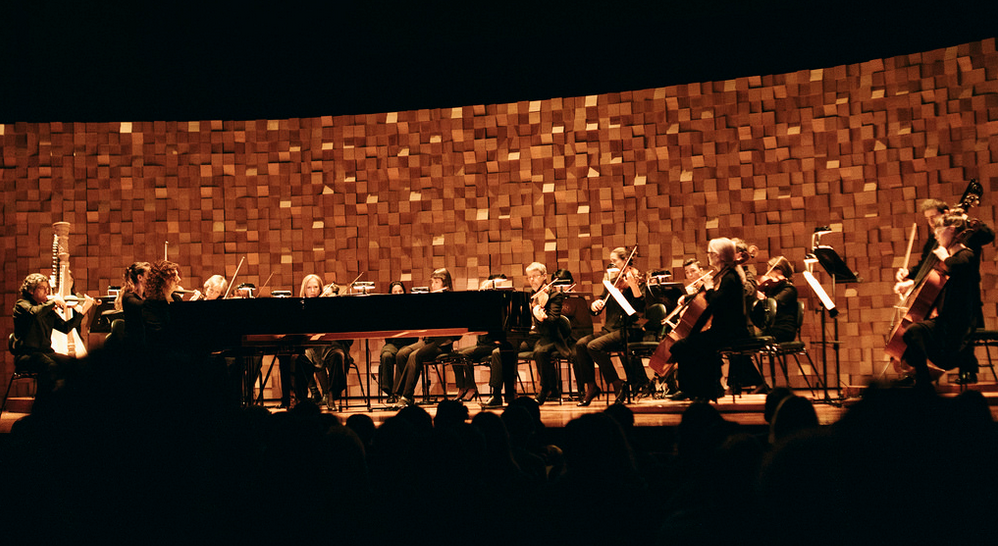I don’t recall ever having received a sheet of instructions before seeing the orchestra. But then again, you get used to the unusual when you attend Dark Mofo.
The winter festival has evolved into a Tasmanian cultural landmark. Hosted by the Museum of Old and New Art in celebration of the solstice, Dark Mofo engulfs Hobart’s waterfront and surrounding buildings in a wave of red and black. Crucifixes adorn flags around the city and posters in shop windows; familiar heritage buildings are lit up like beacons in these icy nights. There are shows of sound and light in multiple venues, and musicians of the Tasmanian Symphony Orchestra presented one of the festival highlights: Silence. The show, masterfully curated by Rainer Jozeps, featured pianist Tamara-Anna Cislowska and a small ensemble of TSO string players led by concertmaster Emma McGrath.
 The Tasmanian Symphony Orchestra and Tamara-Anna Cislowska in Silence at Dark Mofo. Photo © Moorilla Gallery
The Tasmanian Symphony Orchestra and Tamara-Anna Cislowska in Silence at Dark Mofo. Photo © Moorilla Gallery
I received my instructions in paper form before venturing into the Federation Concert Hall, wondering what pleasures awaited. Curiously, the note read: “Be prepared. Silence can be a challenge”. In an abstract homage to the concept of silence, we were told to abstain from making sound for a full minute at the conclusion of each work – including the very last one. “Our shared silence will be hard won. Take it with you into the longest night of the year.” Fortunately, we were permitted to clap when the musicians first entered the stage – but from the moment this ceased, the pressure was on.
The concert opened with a projection above the stage revealing a quote from Walt Whitman; between each piece of music to follow were further musings on darkness and silence from others throughout history such as William Shakespeare, Lao Tzu, TS Eliot, and Mozart. The first piece on the programme was Samuel Barber’s heartrending Adagio for Strings. I have few doubts that most people in the hall would have heard this before – personally, I’ve over-listened. But that didn’t stop the spine-tingling climax as the TSO strings climbed to Barber’s heights. I found the acoustics particularly pleasing on this night – perhaps a combination of my close proximity to the stage; the soundboard having been moved nearer behind the performers than usual; and, of course, the quaint size of the ensemble.
Vasks’ The Fruit of Silence piano quintet was next, ethereal and calming as the players performed under moody golden lighting. My favourite work of the night was Elgar’s Sospiri, Adagio for string orchestra and harp, performed with soothing intimacy.
The idea that silence is as functional as the notes which penetrate it was most obvious in Arvo Pärt’s Für Alina. From its first notes, it unravelled at a meditative pace; each of Cislowska’s movements creating a droplet of sound inside the empty space. Her apposite use of silence in between phrases at once evoked reflection and anticipation.
The work (which I confess I’d been most amused to see on the programme) to wrap up the night was John Cage’s 4’33”. If you’re unfamiliar with this piece, you might understand it as a piece that’s rarely heard – even when it is. The four minutes and thirty-three seconds of ‘silence’ is never really silent, though. Here, it started with the beeping of a cynical audience member’s watch at the very moment Cislowska opened her piano lid to announce the beginning of the piece. There was the occasional cough; sneeze; and noise outside the concert hall, filtering in like thunderous white noise in the comparative soundlessness. But the loudest sound of all during 4’33” was that of my own mind: the internal counting, the involuntary thoughts exclaiming “hey, this is excellent”, the awareness of space and its sheer duration. It’s confronting to sit in room surrounded by hundreds of people, all of us orchestrated to simply listen.
Cislowska closed the piano lid, allowed us to reflect for a further minute after the 4’33”, and then the musicians left the stage. No clapping was to be heard; the audience admirably well-behaved, submissive to the instructions we’d received. Though my hands tingled at the thought of applauding and the necessity of restraint, I was startled to learn how valuable the role of silence can be in a performance. I liked it. At the end, I’d decided that in an ideal world, we’d either clap between all works – and every movement (controversial, I know) – or not clap at all. After this event, I’m leaning toward the latter. The absence of rowdy applauds is an enlightening way to respect the arresting sounds these musicians conjured in the space of silence.











Comments
Log in to join the conversation.